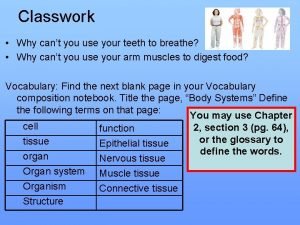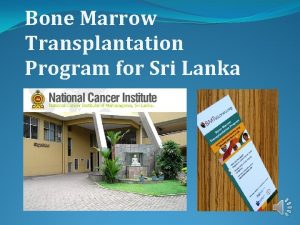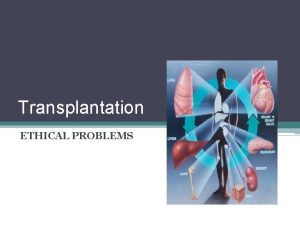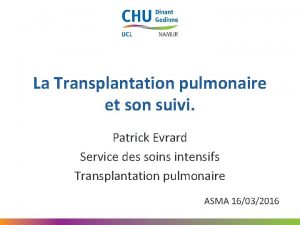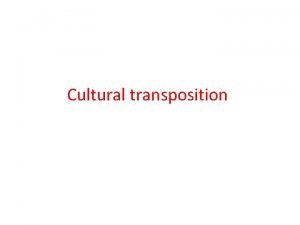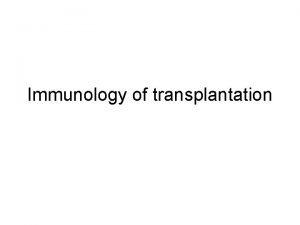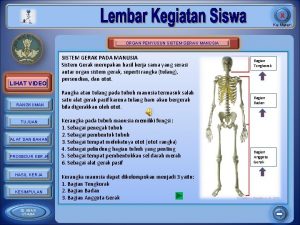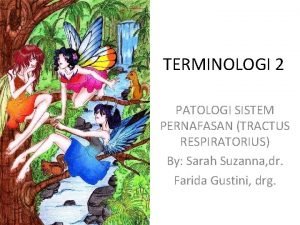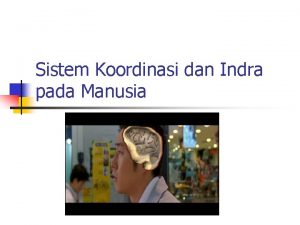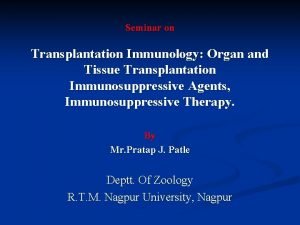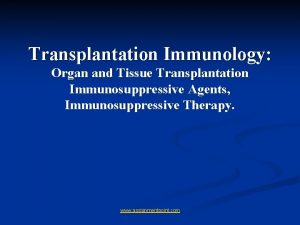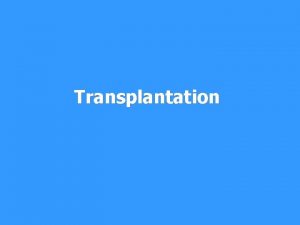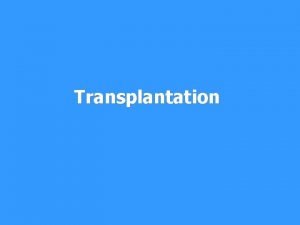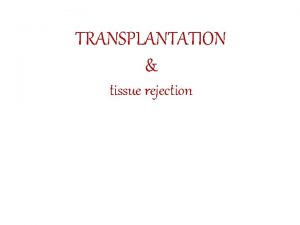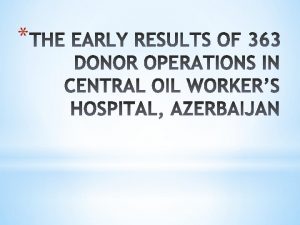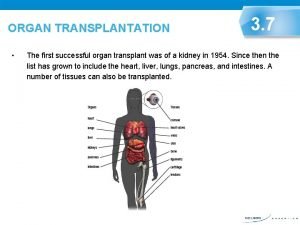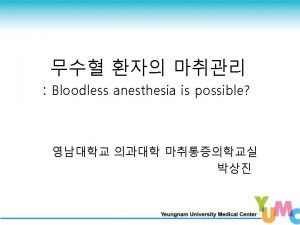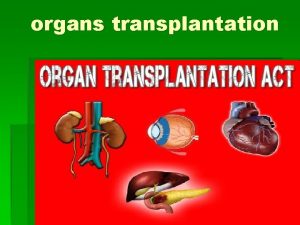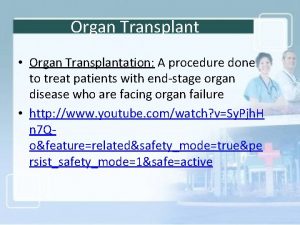Tissue and Organ Transplantation www assignmentpoint com Tissue














- Slides: 14

Tissue and Organ Transplantation www. assignmentpoint. com

Tissue and Organ Transplantation n Today it is possible to transplant many different organs and tissues including. Ø Most common transplantation is blood transfusion. Ø Bone Marrow transplantation Ø Organs : Heart, kidneys, pancrease, lungs, liver and intestines. Ø Tissues : include bones, corneas, skin, heart values, veins, cartilage and other connective tissues. www. assignmentpoint. com

Most Common Transplantation -Blood Transfusion- Transfuse Not transfused www. assignmentpoint. com

Bone Marrow Transplantation n n Used for Leukemia, Anemia and immunodeficiency, especially severe combined immunodeficiency (SCID). About 109 cells per kilogram of host body weight, is injected intravenously into the recipients. Recipient of a bone marrow transplant is immunologically suppressed before grafting. Eg. Leukemia patients are often treated with cyclophosphamide and total body irradiation to kill all cancerous cells. Because the donor bone marrow contains immunocompetent cells, the graft may reject the host, causing graft versus host disease (GVHD). www. assignmentpoint. com

Graft vs. Host Disease Caused by the reaction of grafted mature T-cells in the marrow inoculum with alloantigens of the host n Acute GVHD n n n Characterized by epithelial cell death in the skin, GI tract, and liver Chronic GVHD n Characterized by atrophy and fibrosis of one or more of these same target organs as well as the lungs www. assignmentpoint. com

Heart Transplantation : n n n First heart transplant in South Africa by Dr. Christian Barnard in 1964. One year survival rate is >80%. HLA matching is desirable but not often possible, because of the limited supply of heart and the urgency of the procedure. Lung Transplantation : n n First attempt in 1963 by Hardy and Co - workers. First successful transplantation by Toronto group in 1983. In conjunction with heart transplantation, to treat diseases such as cystic fibrosis and emphysema or acute damage to lungs. First year survival rate is about 60%. www. assignmentpoint. com

Kidney Transplantation : n Diseases like diabetes and various type of nephritis can be elleviated by kidney transplantation. n Survival rate after one year transplantation is >90%. n 25, 000 candidates are waiting for kidney transplantation. Liver transplantation : n It treat congenital defects and damage from viral (hepatitis) or chemical agents. (Chronic alcoholism). n Liver one year survival exceeds 75% and five year is www. assignmentpoint. com 70%.

Pancrease Transplantation : n Offers a cure for diabetes mellitus. n Graft survival is 72% at one year. n Further improved if a kidney is transplanted simultaneously. n Overall goal - to prevent the typical diabetic secondary complications. Skin grafting : n It is used to treat burn victims. n In severe burn, grafts of foreign skin may be used and rejection must be prevented by the use of immunosuppressive therapy. www. assignmentpoint. com

Xenogeneic Transplantation n A major barrier to xenogeneic transplantation is the presence of natural antibodies that cause hyperacute rejection. www. assignmentpoint. com

Immunosuppressive Agents Immunosuppression can be brought about by 3 different ways : n Surgical ablation n Total Lymphoid Irradiation n Immunosuppressive drugs www. assignmentpoint. com

Immunosuppressive Drugs Three main immunosuppressant drugs n n n Cyclosporins act by inhibiting T-cell activation, thus preventing T-cells from attacking the transplanted organ. Azathioprines disrupt the synthesis of DNA and RNA and cell division. Corticosteroids such as prednisolone suppress the inflammation associated with transplant rejection. www. assignmentpoint. com

Immunosuppressants can also be classified depending on the specific transplant: n n Basiliximab in combination with cyclosporin and corticosteroids, in kidney transplants. Daclizumab in combination with cyclosporin and corticosteroids, in kidney transplants. muromonab CD 3 (Orthoclone OKT 3) along with cyclosporin, in kidney, liver and heart transplants. Tacrolimus is used in liver transplants and is under study for kidney, bone marrow, heart, pancreas, pancreatic island cell, and small bowel transplantation. www. assignmentpoint. com

Some immunosuppressants are also used to treat a variety of autoimmune diseases: n n n Azathioprine in treatment of rheumatoid arthritis , chronic ulcerative colitis but limited value. Cyclosporin is used in heart, liver, kidney, pancreas, bone marrow and heart/lung transplantation. Also used to treat psoriasis and rheumatoid arthritis, multiple sclerosis, diabetes and myesthenia gravis. Glatiramer acetate is used in treatment of relapsing-remitting multiple sclerosis. Mycophenolate is used along with cyclosporin in kidney, liver and heart transplants. Also used to prevent the kidney problems associated with lupus erythematosus. Sirolimus in combination with cyclosporin and corticosteroids, in kidney transplants. The drug is also used for the treatment of psoriasis. www. assignmentpoint. com

Conclusion n n More than 50, 000 people, waiting for compatible donor. For ethical an practical reasons, species closely related to human such as Chimpanzee have not been widely used. Xenogeneic transplantation may be major issue of research xenograft technology including genetically modified animal may become a new source of organ supply. Side effects of immunosuppressive agent use for graft need a change of specificity in action and avoiding general immune suppression. Techniques such as transgenic animal production and wide range of research in this field hope to result in opening a new window for the process of transplantation immunology. www. assignmentpoint. com
 Cell tissue organ organ system organism
Cell tissue organ organ system organism Tissue are grouped together to form various
Tissue are grouped together to form various Bài thơ mẹ đi làm từ sáng sớm
Bài thơ mẹ đi làm từ sáng sớm Cơm
Cơm Bone marrow transplantation sri lanka
Bone marrow transplantation sri lanka Law of transplantation
Law of transplantation Patrick evrard transplantation
Patrick evrard transplantation Cultural transposition
Cultural transposition Transplant
Transplant Stem cell or bone marrow transplantation thailand
Stem cell or bone marrow transplantation thailand Organ and organ system
Organ and organ system 3 organ penyusun sistem gerak manusia
3 organ penyusun sistem gerak manusia Foto rontgen efusi pleura
Foto rontgen efusi pleura Organ penyusun sistem koordinasi pada manusia
Organ penyusun sistem koordinasi pada manusia Cell tissue organ system body
Cell tissue organ system body
